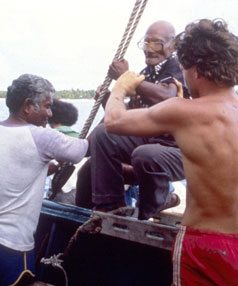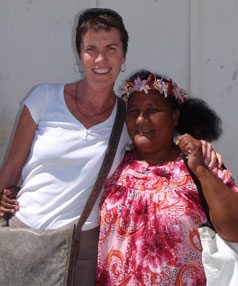On August 6, 1945, the city of Hiroshima was destroyed by a single atomic bomb. Upon impact, thousands of people were instantly carbonised in a blast a thousand times hotter than the sun’s surface. Around 80,000 died instantly, while the final toll climbed to 250,000. On August 9, Nagasaki suffered a comparable fate.
The 65th Anniversary of those tragic events will be remembered today in over 4000 cities around the world.
During the Cold War, nuclear-powered states tested their weapons around the world. The US repeatedly exploded devices in the Pacific, where the legacy from those terrible experiments is still felt today.
Greenpeace is remembering Hiroshima Day by revisiting the Marshall Islands where, in 1985, forty years after Hiroshima, the Rainbow Warrior helped move hundreds of Pacific Islanders away from the deadly fallout of US nuclear testing.
Today, by threatening to cut their aid, the US is pressuring Marshall Islanders to return to their still-contaminated homeland. Greenpeace New Zealand chief, Bunny McDiarmid, reports from Rongelap in the Marshall Islands. These are excerpts from her report.
“Twenty-five years ago, just before the Rainbow Warrior was bombed in Auckland’s harbour, the Greenpeace flagship was in the Marshall Islands to help move 350 people from their irradiated home island of Rongelap. Today those same islanders are being pressured to return home, but many believe that despite some “clean up”, Rongelap is still unsafe. I was aboard the Rainbow Warrior when we moved the people in 1985 and have stayed in touch with them over the years. I am now back again in the Marshall Islands to find out how the community is doing and how they will respond to a US deadline to return to the island next year. The legacy from the terrible experiment that started more than 56 years ago with one of the largest nuclear tests in history, continues today.
The senator of Rongelap, Jeton Anjain, took a big risk when he approached Greenpeace to help relocate his people in 1985, but with no support coming from the US, or his own government, he believed they had no choice. After years of enduring health problems, from high rates of miscarriages and strange birth defects to thyroid cancers, they no longer believed the military doctors that their island was safe.
It took us 11 days to move everyone, from 80-year-olds to newborns and their belongings, to the island of Mejato, in the northwest corner of Kwajalien atoll. The relocation had a profound impact on all of us on board the Rainbow Warrior.
In the 1950s, the Marshall Islands was a UN Trust territory under the care of the US. It was also the site of 67 nuclear tests conducted by the US. One of the largest was “Bravo” in 1954. The fallout from the Bravo test was carried downwind and literally rained down on inhabited islands to the southeast. The people, who had received no warning, were exposed to dangerous amounts of radiation. One of those islands was Rongelap, where 82 people lived at the time. Documents released later revealed that the US military deliberately went ahead with the test knowing that the wind would carry the fallout to these inhabited islands.
The US has resisted taking responsibility for what happened to Rongelap and other affected islands every step of the way. It has consistently downplayed the extent and the degree of exposure and has used double standards when determining “safe” levels of radiation for the Marshallese. It has been an ongoing battle for the people to get information and compensation for their damaged health and their contaminated islands.
One year after the 1985 relocation of the 350 inhabitants, the US government, which was under increasing pressure from other affected communities in the Marshalls, came to an agreement with the Marshall Islands government to pay compensation for the effects of its nuclear testing programme.
The US allocated money to support the displaced Rongelap community on Mejato and to establish a Rongelap resettlement fund after an independent study recommended that radiological clean up was necessary before people could return. One informed estimate set this cost at $US95m. The US agreed to pay $US45m which has severely limited what has been done.
The US appears to want closure and is using financial pressure to force some progress on resettlement. After October 2011, financial support will go only to those living on Rongelap not to those who choose to stay in Mejato.
If people return, they will be restricted in where they can gather local food, how much of the local food can be eaten and where they can live. The Rongelap Council is trying to eke out the Resettlement Fund money to establish some houses, a dock, a runway, a school and a reverse osmosis plant for fresh water and to continue the clean up, but it is not enough to clean up the whole atoll and there are valid questions about whether the most irradiated northern islands can be cleaned with this method.
And, what of those who genuinely feel it is unsafe to move back and will never believe US assertions of safety? Will they really be cut off from any financial support?
The leadership of Rongelap is divided about whether to move back or not and the Marshall Islands government is once again taking a backseat on this so as not to upset relations with the US. But, the first step in protecting the rights of the Rongelap community must be a united front among the Marshallese leadership. No ultimatums given by the US should take away its responsibility to see through a thorough clean up of the land it contaminated or its support for the generations of Marshallese whose health has been compromised. The cost will be minimal compared to the billions that have gone into and continue to go into nuclear weapons development.”
Hiroshima Day will be remembered at candlelight rallies around Australia:
Sydney – Belmore Park (near Central Railway) – 6pm Fri 6 Aug
Brisbane – Brisbane Square, George Street – 1pm Sat 7 Aug
Perth – Cnr of Hay and William Streets (outside Wesley Church) – 12pm Fri 6 Aug
Melbourne – St Paul’s Cathedral (corner of Swanston and Flinders Streets) – 7am Fri 6 Aug
Hobart – Parliament House lawns – 10am Sat 7 Aug



